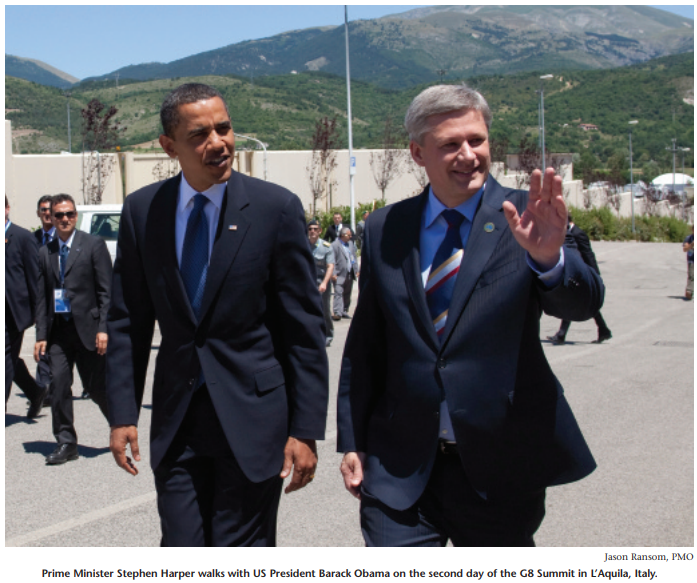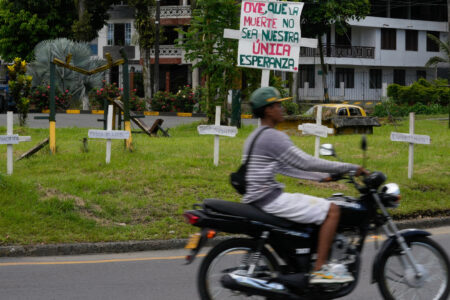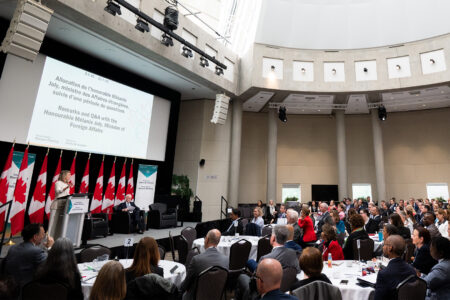
In his elegant 1989 retrospective, Diefenbaker’s World: Populist in Foreign Affairs, Basil Robinson, who served as liaison officer for External Affairs during the Diefenbaker years (1957-63), remarks that it was a time “when international patterns were being shaken up and challenged in ways that could not fail to affect Canada.” Diefenbaker’s record in foreign affairs is mixed, writes Robinson, but in taking the initiative that bridged the transition from the “old” to the multiracial Commonwealth, he won admiration for recognizing the winds of change that were sweeping through the post-colonial world.
A half century later there are new winds of change. “We are living today,” argues the distinguished Canadian diplomat Jeremy Kinsman, “in a unique moment for changing the way the world governs itself, especially when it comes to developing a wider participation in the process.” The recession has revealed the inadequacies of the domestic and international financial rules, created to deal with a postSecond World War situation that is no longer relevant. Globalization and the rise of new economic giants, especially China and India, require a reconfiguration and reform of international institutions. New forms of disorder — climate A change, pandemics, cyberterrorism — have changed the paradigm and introduced a new dimension to issues of peace and security.
As host of next year’s summit in Huntsville (June 25-27, 2010), in Ontario’s Muskoka region, Canada should seize the initiative in bridging the evolution of the G8 to a more representative summit of world leaders. Our pluralism and what Kinsman calls our “multilateralist wiring” — we have a voice in, among other organizations, the Commonwealth, la Francophonie, Asia Pacific Economic Cooperation and the Organization of American States — give us global place and standing and make us well suited to the task. As the long-time beneficiary of the Chinese and Indian diaspora — since 1980 over half our new settlers have migrated from Asia, changing both how we look and how we think — we are well placed to bridge the shifting balance in world order and especially the relationship between Asia, Europe and the Americas.
Canada has been a constructive internationalist in the creation of the post-war architecture. We have played the role of “helpful fixer” through creative initiatives including breaking the log-jam on UN membership, the development of peacekeeping, international law and justice, building a North-South dialogue and creating a representative Commonwealth and Francophonie. Once again we have an opportunity to apply our talent and engage on a broad canvas of issues with a range of countries. It will require hard work. We will have to raise our game and devote sufficient resources to the task. But it will be worth the effort.
The original G6 was created at Rambouillet in 1975 to give the leaders of the major industrialized democracies a forum, with an emphasis on informality, to discuss “open democracy, individual liberty and social advance.” Most of the originals at that 1975 summit — host Valéry Giscard d’Estaing, Helmut Schmidt, Harold Wilson and Takeo Miki — were economists. Gerald Ford was complemented by the formidable brains trust of Henry Kissinger, George Shultz and Bill Simon.
Informality passed into history after Pierre Trudeau squeezed his counterparts into the world’s biggest log cabin at Montebello in July 1981, when Canada hosted its first summit. For the official photo, names are now carefully stencilled onto the floor and as with a game of musical chairs, the reportage focuses less on the substance than on who is last in place. Where once the leaders spent much of the three days together, at L’Aquila, Italy, this year the time together was estimated at less than three hours.
The summit process itself now resembles the medieval caravans of the Crusades: a travelling road show that in the lead-up to Aquila included more than 80 ministerial sessions — finance, trade, energy, environment, labour — and countless more sessions of officials. The agenda has become more complicated and requires the involvement of leaders representing a wider geography. Once at the summit, leaders move like rival posses with their entourage of accompanying ministers, sherpas and supporting officials. The Aquila communiqué — 10 documents amounting to 31,167 words — was the second longest in G8 history.
Meanwhile beyond the walls of the conference site are thousands of armed guards. An equally large group of journalists serve as intermediaries to the professional demonstrators representing a rainbow of causes. They chant, throw things and otherwise seek the attention that will give them Warholian fame. This year’s protest brigade had to contend with both the visible devastation created by April’s earthquake and, in the lead-up to the summit, the Italian tabloids reporting on Silvio Berlusconi’s domestic travails, including tales of “kissing lesbians and orgies.”
In 2004, one chronicler and cataloguer of the G8, the University of Toronto’s John Kirton, looked at the arguments for enlargement in “Getting the L20 Going: Reaching Out from the G8.” The carefully reasoned paper, originally presented to the Brookings Institution, argued that enlargement of this clubby, consensual G8 would be imprudent: the groups served different functions and drew on different legitimacies, and enlargement would be a recipe for gridlock, deadlock and the end of informality.
But today, the case for expansion and reform of the G8 is compelling. Global developments and events have rendered redundant many of Kirton’s observations. The recession forced the creation of a new second table of leaders in the G20. It met first, at the behest of George W. Bush, in Washington last November, and then, at the invitation of Gordon Brown, in London in April. Barack Obama will host the next meeting, in Pittsburgh in late September.
Once again we have an opportunity to apply our talent and engage on a broad canvas of issues with a range of countries. It will require hard work. We will have to raise our game and devote sufficient resources to the task. But it will be worth the effort.
Asked about the future of the G8 in the parting press conference at Aquila, President Obama voiced the obvious when he said, “We have to update and refresh and renew the international institutions that were set up in a different time and place. Some — the United Nations — date back to post-World War II. Others, like the G8, are 30 years old. And so there’s no sense that those institutions can adequately capture the enormous changes that have taken place during those intervening decades. What, exactly, is the right format is a question that I think will be debated.”
What is not in debate, says Henry Kissinger, is that “America will have to learn that world order depends on a structure that participants support because they helped to bring it about.” Obama has announced he is determined to build a “multipartner world” where governments and private groups work collectively on common global problems. Transformation of the G8 is also consistent with its original intent: to be sufficiently representative to effect change. Canada became the first beneficiary of this functional approach when at the 1976 San Juan, Puerto Rico, summit, host Gerald Ford, with the support of German Chancellor Helmut Schmidt, ensured an invitation and membership for Canadian Prime Minister Pierre Trudeau. The president of the European Union (EU) was invited in 1977; in 1996 so were the heads of the International Monetary Fund, the World Trade Organization (WTO) and the World Bank. Russia formally joined the group in 1997, making it the G8. In 2005, as host of the Gleneagles summit, Tony Blair made formal the partial inclusion of China, India, Brazil, Mexico and South Africa in the “G8 plus 5.” Last year in Hokkaido, the Japanese, who had originally opposed any additions, invited Australia, South Korea and Indonesia. At Aquila, the head count of invited leaders reached 40, another recognition that meaningful decisions require wider geographic representation.
In the context of reform we can draw on the considerable research already residing at the University of Toronto with John Kirton’s G8 Research Group, as well as the work of John English at the Centre for International Governance Innovation and Gordon Smith at the University of Victoria. The G8 needs to include the dominant regional power; this would suggest expanding the current G20 group to include Nigeria. Based on the experience of international cabinets — the EU and NATO — Gordon Smith and Barry Carin recommend a format designed to promote effective discussion and make decisions.
As the architect and first chair of the G20 finance ministers, former prime minister Paul Martin first had the idea of a meeting larger than the G7 finance ministers in the wake of the 1994 Mexican peso crisis, but it took the Asian financial crisis of 1997 to convince his G7 counterparts to bring about the 1999 first meeting of the G20 finance ministers and central bankers in Berlin. Martin underlines how important it is to replace the usual set-piece speeches with off-the-cuff exchanges. It requires superb simultaneous translation facilities and careful attention to the structure of the meeting. For example, lunches of the G20 broke into separate sessions for ministers, their deputies and the central bankers. Martin says tracking implementation of decisions, a current weakness of the G8, could be accomplished by tasking the appropriate international organizations (IMF, World Bank, WTO, Financial Stability Board) to provide follow-up reports to leaders. While the host would maintain authority for the agenda, Martin suggests a small, permanent secretariat to provide corporate memory, organizational continuity and recognition of the different capacities of its members; we could look to the experience of the provinces’ Council of the Federation.
As next year’s host, Canada is at the end of the G8 rotation. Then it is the turn of the French, and Nicolas Sarkozy has said that there will be institutional change that would include Africa, Latin America and China. Gordon Smith and others warn there is no guarantee that Canada will make the next cut. Smith points out, for example, that in any objective ranking of the 20 countries having at least 2 percent of global GDP or population, Canada “just scrapes in.” By 2020, we won’t make either list. The British Foreign Office already puts Canada in the second tier of the current G20. We should use our presidency to transform the G8 into a grouping that is more inclusive, pragmatic in design and practical in operation.
For Canada the months before Huntsville are an opportunity to reinforce the emerging consensus for a transformation to a more representative meeting of leaders and to establish an agenda for progress. Events will reinforce the opportunities that, for convenience, can be loosely divided into three interconnected baskets. First, the economic situation. Aquila was essentially a “take note” discussion papering over the differences between those who would argue for a second stimulus (UK and Russia), those who want to assess the effect of the first tranche, of which considerable monies are yet to be expended (Canada, US), and those who are already frightened about the longer-term impact of so much spending (France, Italy, Germany). The Aquila statement also underlined the Canadian argument that, before recovery can begin, it is essential to have healthy banks that are willing to extend credit. Huntsville could also be the venue for discussion of the Chinese idea of a new reserve currency, although holding $2 trillion in US treasuries will reinforce China’s instinctive caution for change. If “green shoots” continue to sprout, then Huntsville will also be the forum for discussion of the exit ramp(s) necessary to avoid the twin threats of deflation or inflation. On the other hand, if Paul Krugman and Gordon Brown are correct in their warnings that the shoots are premature, then the “second wake-up call” will oblige discussion about a new stimulus package.
As the architect and first chair of the G20 Finance Ministers, former prime minister Paul Martin first had the idea of a meeting larger than the G7 finance ministers in the wake of the 1994 Mexican peso crisis, but it took the Asian financial crisis of 1997 to convince his G7 counterparts to bring about the 1999 first meeting of the G20 finance ministers and central bankers in Berlin.
The Aquila summiteers agreed to reinvigorate the Doha Round with an aim of completion in 2010. Pascal Lamy, the director of the 153-member Geneva-based WTO, spoke optimistically about negotiations that are “80 percent complete.” No one is holding their breath. If there is to be real progress it will likely come at the G20 meeting in Pittsburgh. New trade representatives for the US (Ron Kirk) and India (Anand Sharma) have generated improved personal dynamic. Unresolved are the bugbear of agricultural subsidies and the new challenges generated by the recession, including rising protectionism, the increase in trade remedies and the subsidies given to the banks and North American car industry. The US and the EU are already challenging China’s restrictions on the exports of its stockpile of raw materials.
The second basket is climate change. At Aquila, the 17 countries in the G8 and Major Economies Forum, responsible for about 80 percent of the world’s emissions, agreed to limit global warming to no more than 2 degrees Celsius over pre-industrial levels. Scientists reckon that it has risen about 0.8 degrees since 1850 but that at 2 degrees we’d face the kind of catastrophic events predicted by Al Gore and depicted in the 2004 Hollywood blockbuster (filmed in Montreal) The Day after Tomorrow. The G8 agreed among themselves that, to give meaning to their previously agreed target of achieving 50 percent cuts in emissions by 2050, they would shoulder 80 percent of the burden. But as Prime Minister Stephen Harper famously observed, this is an “aspirational” target.
There is also ambiguity about the base date for the reductions — the Europeans say it is 1990 while the North Americans suggest 2005-06. Russia has already stated that sacrificing economic growth for emission control is not on and China, India, Brazil, Mexico and South Africa are not for budging. Indian Prime Minister Manmohan Singh declared at Aquila that “climate change cannot be addressed by perpetuating poverty on emerging countries,” a position reinforced by Brazilian President Luiz Inacio Lula da Silva, who added, “We don’t want to continue to be secondclass citizens. We want to go to the top floor.” Subsequent American discussions with the Indians and the Chinese have underlined this attitude. President Obama put the issue into perspective in Aquila: “Developing nations have real and understandable concerns about the role they will play in these efforts. They want to make sure that they do not have to sacrifice their aspirations for development and higher living standards. Yet, with most of the growth in projected emissions coming from these countries, their active participation are a prerequisite for a solution.”
For their part, the Americans are still some distance from achieving consensus, and notwithstanding the passage of the Waxman/Markey bill in the House of Representatives, legislation in the Senate and reconciliation with the House version are still to be achieved.
The US situation is not the only question mark. The recession, the cost of compliance and the nebulous benefits of “green technology” and new “green jobs” set against the loss of real jobs, are riling both business and labour unions and increasing the league of sunshine environmentalists. Both Australia and New Zealand have already pushed back their implementation plans. German Chancellor Angela Merkel exempted the German steel and cement industry from last year’s EU carbon emissions scheme, and Italy has arranged for the EU plan to be re-examined in light of progress, or lack thereof, at the December conference on climate change in Copenhagen. Developing countries expect financial support as the price of their cooperation. British Prime Minister Gordon Brown has talked of a $100-billion development fund. The prospects for Copenhagen are increasingly looking less like a triumphant finale than the start of a longer-term process. Climate change is likely to figure large at Huntsville.
Third, the peace and security basket of issues, notably nuclear proliferation. At Aquila the leaders condemned “in the strongest terms” North Korea’s nuclear tests and ballistic missile launches in defiance of UN resolutions. On Iran, Russia said it would not support, “at this point,” further sanctions, so the G8 merely declared its “deep concern” and the “sincere hope…” that Iran will seize this opportunity to give diplomacy a chance to find a negotiated solution to the nuclear issue.” President Sarkozy promised world leaders will “take stock” at the annual United Nations General Assembly in September.
President Obama is organizing a nuclear security conference for March 2010 in Washington, where he will push forward on his March 2009 announcement in Prague of a comprehensive nuclear disarmament agenda intended to strengthen the nonproliferation treaty. It will encourage nations to meet their arms control, disarmament and non-proliferation commitments, and to secure nuclear weapons and vulnerable nuclear materials so they do not fall into the hands of terrorists. The conference will build on his Moscow discussions in June with Russian President Dmitry Medvedev. Their joint understanding for a follow-on treaty to the Strategic Arms Reduction Treaty will reduce their nuclear warheads and delivery systems by up to a third from current treaty limitations. The Washington conference is intended to place the burden of proof on countries that are not yet members of the nuclear club to demonstrate that they are complying with the Nuclear NonProliferation Treaty. Scofflaws face the prospect of outside inspection to ensure compliance or relegation to “pariah nation” status with accompanying sanctions.
The Food Security Initiative that will effectively triple spending and shift the emphasis from food aid to investment in farming capacity offers real hope for African countries, especially if the “trust through verification” monitoring system proposed by Canada is implemented.
On each of the three baskets Canada has credibility and capacity to provide constructive solutions. Our approach to financial regulation has been widely praised, including an endorsement from President Obama. On trade policy and in the context of the current EU-Canada free trade negotiations, Huntsville would be a splendid opportunity to reassert our leadership with a unilateral renouncement of supply marketing.
Through listening and perseverance, Environment Minister Jim Prentice aims to have a Canadian consensus on climate change before Copenhagen and plans to begin the drafting of regulatory changes in 2010. Practical experience is vital to effective international action, and the diversity of the Canadian experience — British Columbia’s carbon tax, the carbon capture and storage investments in Alberta, the joint Canada-US carbon sequestration project in Saskatchewan and the acknowledged expertise in hydroelectricity possessed by British Columbia, Manitoba, Newfoundland and Labrador, and especially Quebec — is underestimated and underappreciated.
We should use the international attention that will be focused on Canada around both the Winter Olympics and Huntsville to demonstrate the Canadian experience. Alberta, in collaboration with the oil and gas industry, should offer tours of the oil sands and show the world that the pictures in the National Geographic are an incomplete truth. We should use the coming months to solicit Chinese and Indian investment and to discuss plans for the construction of a rail and pipeline route to the West Coast ports of Kitimat and Prince Rupert. We need other markets, or at the least the possibility of other markets, to prevent American efforts to leverage down prices. We should also aggressively, and in the company of other nations, take on the pernicious “clean energy” border tax that is currently included in the Waxman/Markey legislation.
Canada has a long and distinguished record on disarmament and nuclear non-proliferation. It is time to apply our knowledge and experience. From mines in northern Saskatchwan, we currently supply just over a quarter of the world’s uranium supply. If Canada were to assume stewardship of uranium from “cradle to grave,” it could be a game changer, especially if we were to encourage other suppliers to follow our lead. This would be as big a contribution to international peace and security as was the development of Pearsonian peacekeeping a half century ago.
The global food crisis has been exacerbated by the recession. It is another issue to which Canada, once the “breadbasket of the world,” can bring knowledge and expertise.
In his conclusion to Diefenbaker’s World, Basil Robinson, who would become undersecretary of state for external affairs, observed that the two constants in Canadian policy are, first, consistent support and active association with the major institutions and alliances and, second, a solidarity in global affairs with the United States,” modified by a spirited nationalism in bilateral matters.” It continues to be a sound code for the conduct of Canadian foreign policy.
Basil Robinson was a member of a generation in which Canada’s diplomatic service and foreign policy were muscular, nimble and imaginative. They understood that “being there” required a contribution — ideas and initiatives on peace, security and economic well-being. It meant a commitment to hard power combined with the application abroad of soft power. As a middleweight, we recognized that to compete in the global arena with the heavyweights, required international institutions with rules to even the odds. Canadian efforts to engineer multilateralism, through the UN and its alphabet soup of agencies, and to create collective security, regionally through NATO and bilaterally through NORAD, are the foundation stones of our foreign policy. Adaptability in the face of change, initiatives from peacekeeping to the abolition of land mines and a willingness to stand up in places like Afghanistan are testimony to Canadian constructive internationalism.
As we assume the presidency of the G8, the road to Huntsville is an opportunity to re-examine our international posture, especially as we campaign to win a seat on the UN Security Council in the fall 2010 elections and look toward substantial withdrawal of our troops in Afghanistan in 2011.
Now is the time to think anew about what we want to achieve in the coming decade. We should begin a consultation with Canadians, reaching out to the provinces, business and the wider community, to stimulate new thinking and generate new ideas about how we make and conduct our foreign policy. The decision at Aquila to establish an institute devoted to perfecting technology aimed at capturing and storing carbon, the initiative of Australian Prime Minister Kevin Rudd, illustrated the power of a good idea.
Start the dialogue with this question to Canadians: “What can we do on the world stage that will bear a ‘Made in Canada’ stamp?” The Vancouver/ Whistler Olympics will provide an ideal trampoline to start the conversation to encourage Canadians to think globally.
Transformation of the G8 at Huntsville would be a substantive Canadian achievement in constructive internationalism. Peking, New Delhi, Brasilia, Mexico City and others will appreciate the Canadian initiative. The rest of the world will take note and admire our ability to bridge within the family of nations. Washington will see its fit into the Obama plan for a “multi-partner world.” Of equal importance, it will also serve to reconfirm and reinforce Canadians’ faith in our own capacity to do good and to be seen doing good on the international stage.
Photo: Shutterstock








